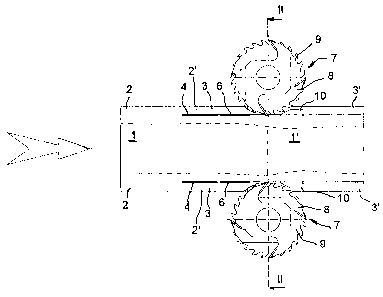Some of the information on this Web page has been provided by external sources. The Government of Canada is not responsible for the accuracy, reliability or currency of the information supplied by external sources. Users wishing to rely upon this information should consult directly with the source of the information. Content provided by external sources is not subject to official languages, privacy and accessibility requirements.
Any discrepancies in the text and image of the Claims and Abstract are due to differing posting times. Text of the Claims and Abstract are posted:
| (12) Patent: | (11) CA 2191121 |
|---|---|
| (54) English Title: | PROCEDURE FOR WORKING A TREE TRUNK BY MACHINING |
| (54) French Title: | PROCEDE DE TRANSFORMATION D'UN TRONC D'ARBRE A L'AIDE D'OUTILS |
| Status: | Term Expired - Post Grant Beyond Limit |
| (51) International Patent Classification (IPC): |
|
|---|---|
| (72) Inventors : |
|
| (73) Owners : |
|
| (71) Applicants : |
|
| (74) Agent: | ROBIC AGENCE PI S.E.C./ROBIC IP AGENCY LP |
| (74) Associate agent: | |
| (45) Issued: | 2005-04-12 |
| (22) Filed Date: | 1996-11-22 |
| (41) Open to Public Inspection: | 1997-05-25 |
| Examination requested: | 2001-03-21 |
| Availability of licence: | N/A |
| Dedicated to the Public: | N/A |
| (25) Language of filing: | English |
| Patent Cooperation Treaty (PCT): | No |
|---|
| (30) Application Priority Data: | ||||||
|---|---|---|---|---|---|---|
|
Procedure for working tree trunks by machining into wood products, such as boards and cants. In the procedure, from trunks (1) preferably trimmed on at least two sides, at first at least one side board (3) is sawn so that at least part of the dull edge (2) remains on the side board (3), whereupon the dull edges (2') of the side board are edged. The side board (3) is moved together with the central section (1') during the edging operation and the side board (3) and the central section (1') are kept at a distance from each other by means of a separating element (6), such as a dividing knife, at least during the edging operation.
Procédé pour le traitement de troncs d'arbres par enlèvement de copeaux en produits de bois, tels que des planches et des bois équarris. Dans le procédé, à partir de troncs (1), de préférence dressés sur au moins deux faces, au moins une planche latérale (3) est sciée de telle manière qu'au moins une partie de la flache (2) reste sur la planche latérale (3), après quoi les flaches (2') de la planche latérale sont équarries. La planche latérale (3) est déplacée en même temps que la section centrale (1') pendant l'opération d'équarrissage et la planche latérale (3) et la section centrale (1') sont maintenues à distance l'une de l'autre par un élément séparateur (6), tel qu'un couteau diviseur, au moins pendant l'opération d'équarrissage.
Note: Claims are shown in the official language in which they were submitted.
Note: Descriptions are shown in the official language in which they were submitted.

2024-08-01:As part of the Next Generation Patents (NGP) transition, the Canadian Patents Database (CPD) now contains a more detailed Event History, which replicates the Event Log of our new back-office solution.
Please note that "Inactive:" events refers to events no longer in use in our new back-office solution.
For a clearer understanding of the status of the application/patent presented on this page, the site Disclaimer , as well as the definitions for Patent , Event History , Maintenance Fee and Payment History should be consulted.
| Description | Date |
|---|---|
| Inactive: Expired (new Act pat) | 2016-11-22 |
| Inactive: Correspondence - MF | 2010-08-10 |
| Inactive: Office letter | 2006-10-12 |
| Inactive: Corrective payment - s.78.6 Act | 2006-10-05 |
| Inactive: IPC from MCD | 2006-03-12 |
| Grant by Issuance | 2005-04-12 |
| Inactive: Cover page published | 2005-04-11 |
| Pre-grant | 2005-01-28 |
| Inactive: Final fee received | 2005-01-28 |
| Notice of Allowance is Issued | 2004-10-25 |
| Notice of Allowance is Issued | 2004-10-25 |
| Letter Sent | 2004-10-25 |
| Inactive: Approved for allowance (AFA) | 2004-10-15 |
| Amendment Received - Voluntary Amendment | 2004-04-02 |
| Inactive: Entity size changed | 2003-11-13 |
| Inactive: S.29 Rules - Examiner requisition | 2003-10-07 |
| Inactive: S.30(2) Rules - Examiner requisition | 2003-10-07 |
| Inactive: Status info is complete as of Log entry date | 2001-04-24 |
| Letter Sent | 2001-04-24 |
| Inactive: Application prosecuted on TS as of Log entry date | 2001-04-24 |
| Request for Examination Requirements Determined Compliant | 2001-03-21 |
| All Requirements for Examination Determined Compliant | 2001-03-21 |
| Application Published (Open to Public Inspection) | 1997-05-25 |
There is no abandonment history.
The last payment was received on 2004-10-27
Note : If the full payment has not been received on or before the date indicated, a further fee may be required which may be one of the following
Please refer to the CIPO Patent Fees web page to see all current fee amounts.
Note: Records showing the ownership history in alphabetical order.
| Current Owners on Record |
|---|
| KAUKO RAUTIO |
| Past Owners on Record |
|---|
| None |